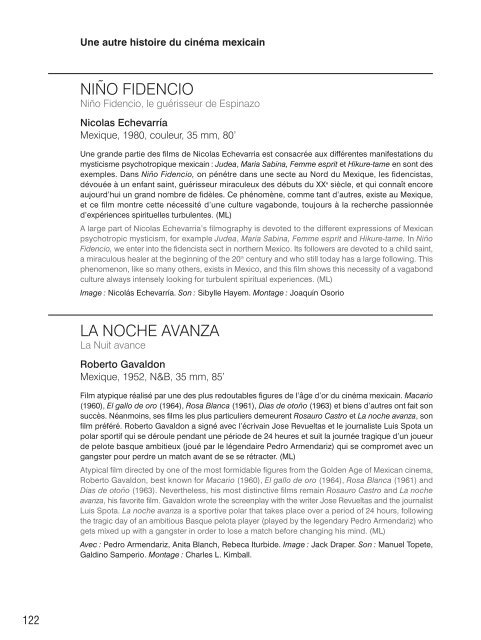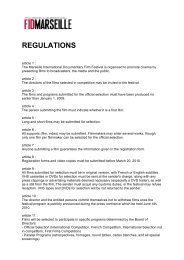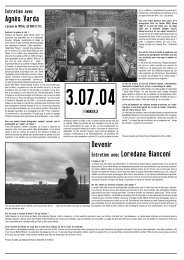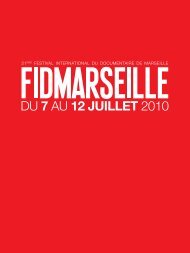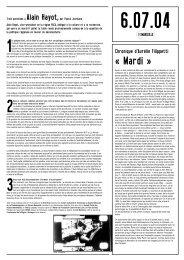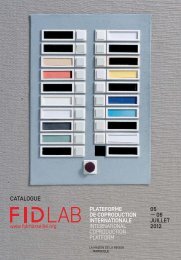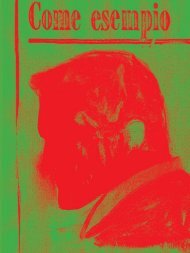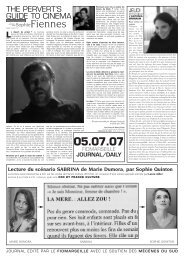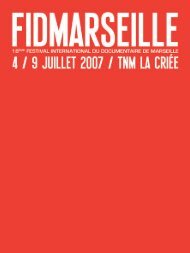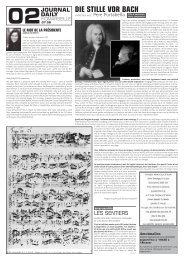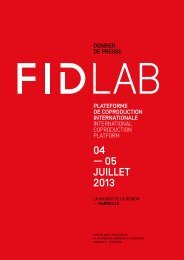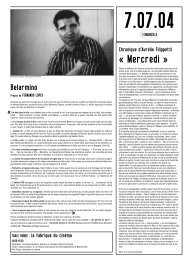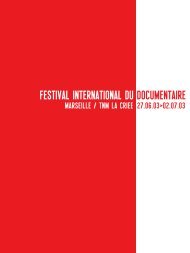FID Marseille 2011 - Festival international du documentaire de ...
FID Marseille 2011 - Festival international du documentaire de ...
FID Marseille 2011 - Festival international du documentaire de ...
You also want an ePaper? Increase the reach of your titles
YUMPU automatically turns print PDFs into web optimized ePapers that Google loves.
Une autre histoire <strong>du</strong> cinéma mexicainNIÑO <strong>FID</strong>ENCIONiño Fi<strong>de</strong>ncio, le guérisseur <strong>de</strong> EspinazoNicolas EchevarríaMexique, 1980, couleur, 35 mm, 80’Une gran<strong>de</strong> partie <strong>de</strong>s films <strong>de</strong> Nicolas Echevarria est consacrée aux différentes manifestations <strong>du</strong>mysticisme psychotropique mexicain : Ju<strong>de</strong>a, Maria Sabina, Femme esprit et Hikure-tame en sont <strong>de</strong>sexemples. Dans Niño Fi<strong>de</strong>ncio, on pénétre dans une secte au Nord <strong>du</strong> Mexique, les fi<strong>de</strong>ncistas,dévouée à un enfant saint, guérisseur miraculeux <strong>de</strong>s débuts <strong>du</strong> XX e siècle, et qui connaît encoreaujourd’hui un grand nombre <strong>de</strong> fidèles. Ce phénomène, comme tant d’autres, existe au Mexique,et ce film montre cette nécessité d’une culture vagabon<strong>de</strong>, toujours à la recherche passionnéed’expériences spirituelles turbulentes. (ML)A large part of Nicolas Echevarria’s filmography is <strong>de</strong>voted to the different expressions of Mexicanpsychotropic mysticism, for example Ju<strong>de</strong>a, Maria Sabina, Femme esprit and Hikure-tame. In NiñoFi<strong>de</strong>ncio, we enter into the fi<strong>de</strong>ncista sect in northern Mexico. Its followers are <strong>de</strong>voted to a child saint,a miraculous healer at the beginning of the 20 th century and who still today has a large following. Thisphenomenon, like so many others, exists in Mexico, and this film shows this necessity of a vagabondculture always intensely looking for turbulent spiritual experiences. (ML)Image : Nicolás Echevarría. Son : Sibylle Hayem. Montage : Joaquín OsorioLA NOCHE AVANZALa Nuit avanceRoberto GavaldonMexique, 1952, N&B, 35 mm, 85’Film atypique réalisé par une <strong>de</strong>s plus redoutables figures <strong>de</strong> l’âge d’or <strong>du</strong> cinéma mexicain. Macario(1960), El gallo <strong>de</strong> oro (1964), Rosa Blanca (1961), Dias <strong>de</strong> otoño (1963) et biens d’autres ont fait sonsuccès. Néanmoins, ses films les plus particuliers <strong>de</strong>meurent Rosauro Castro et La noche avanza, sonfilm préféré. Roberto Gavaldon a signé avec l’écrivain Jose Revueltas et le journaliste Luis Spota unpolar sportif qui se déroule pendant une pério<strong>de</strong> <strong>de</strong> 24 heures et suit la journée tragique d’un joueur<strong>de</strong> pelote basque ambitieux (joué par le légendaire Pedro Armendariz) qui se compromet avec ungangster pour perdre un match avant <strong>de</strong> se se rétracter. (ML)Atypical film directed by one of the most formidable figures from the Gol<strong>de</strong>n Age of Mexican cinema,Roberto Gavaldon, best known for Macario (1960), El gallo <strong>de</strong> oro (1964), Rosa Blanca (1961) andDias <strong>de</strong> otoño (1963). Nevertheless, his most distinctive films remain Rosauro Castro and La nocheavanza, his favorite film. Gavaldon wrote the screenplay with the writer Jose Revueltas and the journalistLuis Spota. La noche avanza is a sportive polar that takes place over a period of 24 hours, followingthe tragic day of an ambitious Basque pelota player (played by the legendary Pedro Armendariz) whogets mixed up with a gangster in or<strong>de</strong>r to lose a match before changing his mind. (ML)Avec : Pedro Armendariz, Anita Blanch, Rebeca Iturbi<strong>de</strong>. Image : Jack Draper. Son : Manuel Topete,Galdino Samperio. Montage : Charles L. Kimball.122


